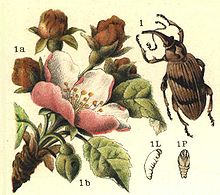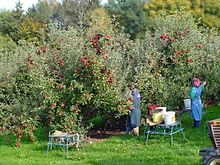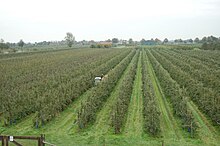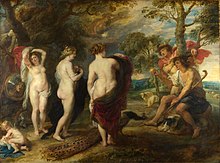Cultivated apple
| Cultivated apple | ||||||||||||
|---|---|---|---|---|---|---|---|---|---|---|---|---|

Cultivated apple ( Malus domestica ), blossoming tree |
||||||||||||
| Systematics | ||||||||||||
|
||||||||||||
| Scientific name | ||||||||||||
| Malus domestica | ||||||||||||
| Borkh. |
The cultivated apple ( Malus domestica Borkh. , Synonym : Pyrus malus L. ) is a well known type of the genus of the apples in the family of the rose family (Rosaceae). It is an economically very important type of fruit. The fruit of the apple tree is called an apple .
Apples are grown both as food in fruit growing and as an ornament . They are also believed to have a medicinal effect . As the fruit par excellence, the apple and apple tree symbolize the subject areas of sexuality, fertility and life, knowledge and decision, and wealth.
description

Habit and foliage
The cultivated apple is a deciduous tree that forms an 8 to 15 meter high, widely spreading treetop in the wild. In fact, this type of growth is seldom observed, as the individual varieties in connection with their rootstocks often show a height that is very different from this (in extreme cases, the high stem and the spindle bush), which is also not expressed by the cut .
The alternate leaves are oval, round to egg-shaped or elliptical, mostly serrate, rarely with entire margins and sometimes lobed.
Wood
The wood of the cultivated apple is similar to that of the crab apple , has a light reddish sapwood and a reddish brown core . It is hard and heavy and is one of the local precious woods . The mighty trunks of the cider apple trees provide the best pieces.
Inflorescences and flowers
The flowers stand alone or in golden panicles . The fivefold, radial flowers are semi-double or in some varieties filled , mostly flat cup-shaped, often fragrant and generally have a diameter of two to five centimeters. The five petals are white or slightly pink, always clearly reddish when budded. Depending on the flower, there are many stamens and five carpels .
The apple tree in Central Europe mostly blooms in May. The beginning of flowering of the apple marks the beginning of full spring in the phenological calendar . By logging the local displacements of the apple blossom, conclusions can be drawn about generally observable climate changes. In this respect, it is regarded as an indicator of global warming . As a result, since the 1950s, the apple blossom in northern Germany, for example, has shifted forward by almost two weeks.
The apple blossom is a typical bee blossom. The fact that five percent of the blossoms, when pollinated, ripen into fruit is enough for a full harvest in the case of apples or pears, while the corresponding proportion is 25 percent for stone fruits .
fruit
However, the fleshy tissue ( pulp ) of the apple, which is usually referred to as fruit, does not arise from the ovary , but from the flower axis . Biology therefore speaks of false fruits . The apple fruit - for which the apple is typical - is a special form of the pelvic fruit . A bellows consists of a carpel that grows together with itself at a seam. Inside the flesh, the bellows-like carpel creates a parchment-like casing. The pulp itself contains at most a few stone cell nests .
Apples ripen after harvest. They are among the climacteric fruits . An enclosed apple and a cover allow bananas and other fruits to ripen faster. The reason is the gaseous plant hormone ethene , which is released during subsequent ripening. Due to the enzymatic browning , the pulp, where it is not protected by the skin , browns at different rates depending on the variety and vitamin C content. This is harmless to health, but affects the medicinal healing effect . Brown rot associated with mold leads to increased patulin levels in apple juice.
When eaten raw, the hard core is usually spurned. It is often said that apples should not be eaten whole because their kernels ( seeds ) contain hydrocyanic acid . The hydrogen cyanide content of apple seeds is very low, varies depending on the variety and is harmless when eating a few whole apples.
Chromosome number
The number of chromosomes is 2n = 34 or 3n = 51.
ecology
The cultivated apple is a winter-bare deciduous tree. The root carries a VA mycorrhiza .
The flowers are feminine, fragrant "nectar-bearing disc flowers". The flowers are particularly frequented by bees . The nectar is given off by the flower cup and is extremely rich in sugar at 75 percent. Cross-pollination is mandatory. Some apple varieties cannot even be crossed with one another (inter-sterility). Pollen-eating beetles also visit the flowers.
Apple fruits are the intergrowth product of five follicle-like, mostly two-seeded individual fruits, which form both the parchment-like housing and the flower cup. As the fruit ripens , the latter grows into the powerful, sugar-rich (up to approx. 13 percent) "pulp". It is mainly digestive spread by humans, in addition swimming spread of whole apples and processing spread e.g. B. by rodents . The well-known brown coloration of the cut surfaces of an apple is caused by the oxidation of the polyphenol chlorogenic acid . Ripening apples produce gaseous ethene , which promotes ripening of other fruits nearby; this can also lead to their premature spoilage. The seeds of the apple are usually in a seed dormancy d. In other words, they are only capable of germination when the inhibitors under the seed coat have been broken down in a moist germinal bed.
Because the cultivated varieties are not resistant to seeds, they are mainly propagated by grafting ( vegetative propagation ). Usually the desired varieties are grafted onto a well-growing base. Overgrown apple trees also reproduce abundantly through root shoots. The Marssonina-leaf drop disease is an infectious disease of the culture apple.
Origin and origin
The cultivated apple is a cultivated form which, according to previous representations, was created by crossing the still wild crab apple ( Malus sylvestris ) with Malus praecox or Malus dasyphylia . But recent genetic studies have a descent from the Asiatic wild apple ( Malus sieversii ) with cross-breeding of the Caucasus apple ( Malus orientalis ) or the cherry apple ( Malus baccata out). The three wild apple varieties mentioned at the beginning were probably crossed quite early.
The original home of the cultivated apple is therefore Asia . Nothing is known about its spread to Central Europe , it may have come via trade routes , as the fruit was considered a life-extending remedy . Wild boar and horses also probably contributed to the spread through seeds.
Ingredients of apple fruit
| Nutritional value per 100 g of apple | |
|---|---|
| Calorific value | 217-228 kJ (52-55 kcal) |
| water | 85 g |
| protein | 0.3 g |
| carbohydrates | 11.4 g |
| - of which sugar | 10.3 g |
| - fiber | 1 g |
| fat | 0.4 g |
| Vitamins and minerals | |
| vitamin C | 12 mg |
| Calcium | 7 mg |
| magnesium | 6 mg |
| potassium | 144 mg |
The average fruit of the cultivated apple consists of 85 percent water.
The complex aroma of the apple is made up of numerous substances. There are large varietal differences in the quantitative composition of the apple's flavoring substances. Essentially, esters , aldehydes and alcohols are involved in the apple aroma. The most important esters include ethyl 2-methylbutyrate , ethyl butyrate , 2-methylbutyl acetate , butyl acetate , hexyl acetate and methyl 2-methylbutyrate . Hexanal and 2-hexenal are among the aldehydes, some of which are only formed when chewing or chewing in the mouth through a very rapid enzymatic conversion of fatty acids and which are often referred to as green notes (taste of green apples like Granny Smith) . In the case of alcohols, 1-butanol , 2-methylbutanol , 1-hexanol and 2-hexenol are important. Other key flavorings in apples are β-damascenone and α-farnese .
The apple aroma is strongly influenced by the apple variety, climatic factors, the time of harvest and the storage time after harvest. In the early ripening stage, esters are often hardly detectable. If fruit is stored for a longer period, the ester content can increase dramatically, depending on the variety. This aroma formation during post-ripening is only perceived as pleasant and harmonious to a certain extent. In the final phase, the apples are sensorially rejected as overripe and perfumed. The post-ripening and the associated aroma development can be stopped or slowed down by cooling and storage under a controlled atmosphere, which makes it possible to offer apple qualities that are acceptable to the senses for a whole year. Apples with a pronounced natural wax layer on the skin (which can be used to make an apple shiny by polishing) have a longer shelf life because of this layer, which prevents it from drying out.
use
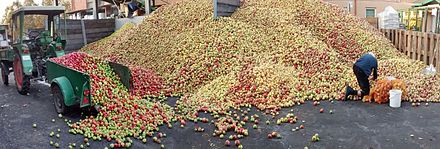
The Celts and Teutons already processed the small and hard fruits of the local apple. They cooked the fruit to puree and made cider from it. The juice was fermented together with honey to make mead . In addition, his is nectar of 9 to 87 percent sugar content and sugar value of up to 1.37 mg of sugar per flower per day for the bees an important costume in the production of honey.
The cultivated apple is of paramount importance in fruit growing. This is because it is the most versatile of all domestic fruit types . There are therefore by far the greatest number of cultivated forms of the apple; in our latitudes it is considered to be the “fruit”.
sorts
The oldest documented cultivar of the cultivated apple is probably the Borsdorf apple , which was mentioned by the Cistercians as early as 1170 .
Around 1880 more than 20,000 apple varieties were cultivated worldwide, including over 2,300 varieties in Prussia alone . From the beginning of industrialization until the early 20th century, a variety of fruit growing and breeding to supply the urban areas was politically promoted and motivated. With the support of fruit growing literature and pomologists' associations , a large variety of regional varieties was documented and preserved.
Today there are around 1,500 varieties in Germany, but only 60 of them are economically important. The elaborate cultivar knowledge and the preservation of old or no longer industrially used varieties are now carried out by various associations.
Only around 30 to 40 varieties are currently available in gardening shops and direct marketers - and the trend is downward. In the supermarket displays, the range is even shrinking to five to six global apple varieties. In addition to the diversity of the range, the inner qualities of the varieties are also increasingly being lost. Recently, people have also been talking about branded apples, so-called club varieties , such as ' Pink Lady ', which can only be sold under license.
The different apple varieties are divided into the apple ripening classes summer, autumn and winter apple.
- Comparison of apple varieties based on various criteria
Apple variety comparison at the State Garden Show in Öhringen (2016)
Acid content of different apple varieties
Sugar content of different apple varieties
Vitamin C content of various apple varieties
Table types in modern fruit growing
The apple has its greatest importance as a table apple ; in Germany it makes up around 75 percent of the total harvest. The varieties that are normally grown as dessert fruit in large-scale cultivation are geared towards the requirements of the fresh market in the food retail sector. The apples must be crisp and juicy and easy to store and transport . Many local varieties do not meet these requirements, which is why only a few varieties are grown in commercial fruit growing - but these are often found around the world.
Because of the high yield, paired with the high water content of the fruit, the apple is the juice fruit par excellence, the majority of the annual apple harvest is liquefied as juice apples: 450 companies in Germany produce one billion liters of apple juice every year . Among the 41 liters of fruit juices and nectars that every German citizen consumes each year according to the German Federal Statistical Office , apple juice is the front runner with an annual per capita consumption of 11.7 liters. Only then comes orange juice with 9.8 liters. The numbers are similar in Austria and Switzerland.
In Europe, three common apple varieties make up almost 70 percent of the total supply on the apple fruit market:
Other economically important varieties that can be grown commercially at low cost (sorted in roughly descending order of economic importance):
Use of old apple varieties
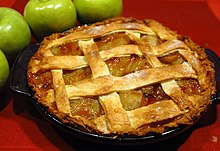
The term “ old apple variety ” refers to varieties that were created before around 1940. Some are - due to local climatic or cultural circumstances - still of regional importance, some can only be found sporadically in fruit growing test facilities .
The apple is the type of fruit that has been available for most of the year. For this reason, old cottage gardens usually had a whole series of apple trees which, thanks to their optimal degree of ripeness, ensured a continuous supply of fruit from early summer to the next spring .
- The white clear apple will be available as a dessert fruit from mid-July . The apple from Croncels follows in August, and Jakob Fischer in early September . Zuccalmaglios Renette is one of the last varieties to come from the tree in early November.
Old table apple varieties with a particularly pleasant taste , which are no longer grown commercially because they are not very productive, have small fruits or are difficult to cultivate, include:
Some apple varieties were specifically used as storage apples . This stored fruit was previously stored in damp and cool cellars. Nowadays that is difficult to do in our modern homes. When it comes to apples, there are varieties that do not spoil until May. Varieties that are harvested late are called winter apples and are usually only edible after Christmas .
- Typical storage apples are: the red ice apple , an age-old variety that used to be stored in stacks until June, the Ontario apple , fresh from the tree only has a mediocre taste, gains with increasing storage, best before April, bell apple with tart, bell-shaped fruit.
A commercial apple is a variety that is primarily intended for use in juice, must , baking or cooking apples and which are usually not table apples. Examples would be Jakob Lebel , Rheinischer Winterrambur or Westfälischer Gülderling .
In apple juice production, a high proportion of acid is important, which is why the older, more acidic varieties from orchards and private gardens are used, especially since the commercial cultivation of special apples for juice production is hardly profitable in Central Europe. The vast majority of apple juice sold in Germany comes from low-acid varieties from commercial fruit-growing, which is why ascorbic acid is added to the juice .
- The special cider apple is used to make alcoholic beverages such as apple wine , cider , clear schnapps ( fruit brandy and calvados ).
The apple is also ideal as a cooked fruit . Cooked apples are usually very sweet and still quite sour, and they do not lose their firm consistency and aroma when heated. There is, for example, the Behm apple , which owes its name to the famous pastries of the Bohemian cuisine (in areas outside Eastern Austria more known as Viennese cuisine ), above all the apple strudel, which has achieved international reputation .
The apple is the ideal fruit for preserving because it acts as a natural preservative and gelling agent due to its high pectin content . Except for applesauce , it is used or added to make other types of fruit suitable for boiling. The fruits of many wild apples can also be juiced and processed into apple jelly; some can only be enjoyed cooked.
Medicinal plant
The apple already appears as a medicinal plant in an old Babylonian script from the 8th century BC, which lists the plants of the medicinal herb garden of King Marduk-apla-iddina II . The medieval medicine wrote all sorts of healing the apple effects to. The majority of the fruits of the apple varieties of that time are likely to have been richly sour , tannic and woody for today's taste . Often it is still in the dark how, when and which parts of the apple plant were used.
- The consumption of fruits with shell generally has an astringent and a laxative and germicidal effect.
- Apple is also good for the stomach .
Apple fiber is a dietary fiber that is extracted from juiced and dried apples. It contains a high proportion of pectins .
Regular consumption of apples reduces the risk of developing heart and vascular diseases, asthma and pulmonary dysfunction, diabetes mellitus and cancer . In the case of cancer, these are in particular colon and lung cancer . Several studies, animal experiments, and epidemiological data conclude that regular consumption of apples has cancer-preventing effects . The pectins and polyphenols , such as quercetin , contained in apples are probably responsible for this. The epidemiological data could also be confirmed in animal experiments. Mice and rats that were supplemented with apples developed up to 50 percent fewer tumors. The tumors were also smaller and the metastasis less pronounced than in the animals that did not eat apples. The same effect was found with apple juice , the cloudy apple juice being more effective here. Probably the cause here are the procyanidins , which are present in high concentrations in cloudy apple juice. Apple tea is prepared as a drink from dried or fresh apple pieces. The English proverb An apple a day keeps the doctor away sums up the health-promoting effects of the apple fruit.
Studies have repeatedly shown that apples from conventional agriculture , in contrast to apples from organic agriculture , are usually contaminated with several pesticides at the same time.
marketing
January 11th has been dedicated to the German apple since 2010. The day of the German apple was called by all major apple producer organizations in Germany to life. Initiators support the day of action , which takes place as part of the consumer campaign “Germany - My Garden”. On January 11, 2010, 40,000 apples were distributed free of charge in the five major cities of Berlin, Hamburg, Cologne, Leipzig and Munich. The aim of the measure was to draw attention to German apples and to increase knowledge about the different varieties and their areas of application.
In Austria, Apple Day is celebrated every year on the second Friday in November . This is to draw attention to the high vitamin and mineral content, the ability to quench thirst and the positive health effects.
Economical meaning
World production
According to the Food and Agriculture Organization (FAO) of the United Nations, around 86.1 million t of apples were harvested worldwide in 2018 . The 20 largest producers together reaped 73.5% of the world harvest. The largest European producers were Poland, Italy and Russia. For comparison: In Austria 387,954 t and in Switzerland 222,431 t were harvested in the same year .
| rank | country | Quantity (in t ) |
rank | country | Quantity (in t) |
|
|---|---|---|---|---|---|---|
| 1 |
|
39.233.400 | 11 |
|
1,462,360 | |
| 2 |
|
4,652,500 | 12 |
|
1,198,517 | |
| 3 |
|
3,999,523 | 13 |
|
1,195,007 | |
| 4th |
|
3,625,960 | 14th |
|
1,130,335 | |
| 5 |
|
2,519,249 | 15th |
|
829.636 | |
| 6th |
|
2,414,921 | 16 |
|
813.064 | |
| 7th |
|
2,327,000 | 17th |
|
756.100 | |
| 8th |
|
1,859,400 | 18th |
|
704.727 | |
| 9 |
|
1,737,412 | 19th |
|
700.198 | |
| 10 |
|
1,727,277 | 20th |
|
696.950 | |
| world | 86.142.200 |
World trade
The largest exporters in 2016 were China (1,322,042 t), followed by Poland (1,093,132 t) and Italy (1,049,438 t).
Apple growing

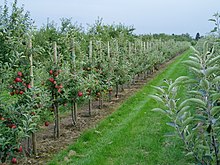
It is one of the early cultural achievements to switch the use of apples as food from chance discoveries to caring for the apple tree, and it could be older than the typical agricultural methods: It can also be carried out in a non-sedentary way of life.
The fruit-growing , as we know it today, have in Central Europe Romans introduced. According to the sources, they began targeted breeding and brought the art of grafting and cloning to their colonies and provinces. The apple has been grown in Central Europe since the 6th century . From the 16th century it became an economic asset .
In Germany, the fruit growing pioneer Otto Schmitz-Hübsch planted the first apple orchard in 1896 and at the same time introduced dense planting with low- stem trees .
Culture
The culture succeeds best in moderately nutritious, moist, but water-permeable soil in full sun. Apples are frost hardy . The seedlings (from the kernels = seeds) of an apple are never pure. For the maintenance and breeding of apple varieties, only the different techniques of vegetative propagation are suitable .
Root grafting
This method brings selected partners together in order to obtain certain characteristics. For this purpose, a rootstock , i.e. a variety that is exclusively responsible for the root or trunk structure, is refined with an annual shoot of the desired noble variety . This noble variety with its branches forms the tree crown and the fruit-bearing parts of the tree in the following years .
Crown finishing
In the case of varieties that either grow too weakly, do not grow straight, or are not frost-hardy, intermediate grafting has prevailed. On the desired root base, a master builder is refined (usually ooculate ) with one of the methods of plant refinement , in order to be refined with one or more apple varieties at the treetop height when the tree has reached the desired stem height.
Alternative documents
In the past, only seedlings grown from kernels were available as rootstocks (see also the Bittenfelder and Jakob Fischer varieties ), but now, with special rootstock breeding, plant characteristics suitable for commercial fruit growing have been achieved. Rootstocks drawn from apple pits almost always form powerful roots and trunks, only bear fruit after 8 to 10 years and are the basis of historical orchards or individual trees. The rootstocks for commercial fruit growing, selected according to the desired properties and vegetatively propagated, hardly form wood (such "trees" need lifelong support structures), have shallow roots, so that artificial irrigation is necessary in dry periods, but already after a few years bring a higher fruit yield per area than the high tribes .
Multiplication
To propagate rootstocks, apple pips are sown in the seedbed in autumn. They have to be made germinable ( stratified ) by exposure to cold . Apple kernels often have germ-inhibiting substances that are only broken down during fermentation processes - kernels made from pressed material (pomace) are therefore particularly suitable for germination, while kernels that are simply put aside when eating apples rarely germinate. The small apple shoots can then be grafted in the following years.
The cultivated apple varieties as soon as they are stable as a species and interesting, by vegetative propagation , cloning (asexual reproduction, which emanates from a sexually bred individual) or by finishing / grafting on an apple strain (usually only on a rooted branch - due to lower Costs) increased.
There is a great risk that varieties that have been forgotten will be irretrievably lost. In principle, though an apple tree is sufficient to obtain a variety of apple, as each apple by refinement or clones any number of reproduced can be. However, an apple tree with a lifespan of around 100 years is not very durable (in comparison: linden trees, for example, can live up to 2,000 years).
Nowadays attempts are being made to preserve and increase the genetic wealth contained in the high variety of varieties by identifying and collecting old varieties, or at least to slow down the impoverishment. In particular, this genetic wealth would be very important in new breeding . However, this is not currently practiced. In Germany, among others, the Julius Kühn Institute in Dresden- Pillnitz makes a valuable contribution to the collection of old and new apple varieties; for Great Britain the National Fruit Collection in Brogdale, a suburb of Faversham , should be mentioned here. The preservation of old apple varieties is otherwise difficult to use commercially and such a task can hardly be accomplished with industrial methods; For old apple varieties, orchards are therefore an important cultivation location.
Pests, diseases, storms
The fire blight is currently (2008) by far the most serious threat to fruit growing in Central Europe - today's commercial cultivation varieties in particular are highly susceptible, but it also attacks many of the old varieties aggressively.
The following pests and diseases can cause problems in apple growing:
- Leaf damage that weakens the tree's photosynthetic capacity and leads to reduced fruit yield:
- Red spider (fruit tree spider mite ), apple rust mite , various caterpillars , powdery mildew
- Fruit damage that reduces the value of the yield or makes it completely unusable:
- Aphids also release a secretion that makes the fruit sticky
- The females of the apple blossom picker lay an egg in a bud in spring. The larva eats this and then cuts the petals. As a result, the flowers do not develop and consequently no fruit is formed
- The codling moth larvae attack the fruit (colloquially known as "worm-eaten")
- Apple scab attacks the fruit and is a purely aesthetic problem. It makes the apples unsightly for sales purposes, but it can be an indication of spray-free culture
- Apple sawfly (Hoplocampa testudinea)
- Glassiness , a metabolic disorder
- Speck , a symptom of deficiency
- Meat browning , which leads to unappealing fruits
- Monilia fruit rot leads to brown, moldy fruits
- Plant damage that can weaken the entire tree or lead to total death:
- Fire blight , tumors , excessive mistletoe infestation.
- Apple aphid
- Fruit tree cancer
- Apple mosaic virus
- Apple shoots , disease caused by phytoplasms .
Fruits are also damaged by sunburn , whereas kaolin can be used as a sunscreen in an aqueous suspension.
In addition, throughout can fruit growing also wind - snow damage or hail and extreme late frosts regionally lead to serious harvest losses.
Growing areas
In some regions, orchards and apple tree avenues are also common.
The economically most important apple-growing regions in Europe are Normandy and the Po Valley . The whole Mediterranean area is grown for export, classic fruit growing areas in Central Europe are:
- Northern and Central Germany : Meckenheim (Rhineland), Wetterau (Hesse), Werder (Havel) , Altes Land , Fahner Heights (Thuringia), Borthen , Muldental and Kohrener Land in Saxony , Palatinate
- Alpine region : Around Lake Constance , East Styria ( apple village Puch bei Weiz , Styrian apple road ), Mostviertel , Lavanttal , South Tyrol
Large quantities of apples are imported from the southern hemisphere - mainly New Zealand , Chile and Argentina - and cover most of the northern hemisphere's apple demand in spring and summer.
Fruit growing in Germany
In 2015, 973,000 tons of apples were harvested in Germany, which is 13 percent below the previous year's figure, but slightly above the long-term average of 972,000 tons. In the following year 2016, the harvest increased to 1,032,090 tons. In 2017, the harvest fell to a record low, with only 596,700 tons harvested. Mainly to blame was a short frost period during the fruit blossom in April. However, the record low was directly followed in 2018 by a record high of 1,198,500 tons.
The apple prices of the four largest producing countries in the EU (Germany, France, Poland and Italy) have been around 0.68 euros / kilogram on a long-term average.
The largest fruit-growing area in Germany is the Alte Land along the southern bank of the Elbe in Lower Saxony and, to a small extent, in Hamburg. The cultivation area in the Altes Land is around 10,700 hectares. In the old country, fruit was already grown in the 17th century. The second largest fruit or apple region in Germany is the Lake Constance region with around 8,500 hectares of cultivation area. Around 1,200 fruit farmers grow fruit here and produce 1.5 billion Lake Constance apples annually. On Lake Constance, Jonagold , Elstar , Idared and Gala , but also old varieties such as Cox Orange and Schöner from Boskoop , are among the most common and popular cultivated apple varieties that benefit from the comparatively high periods of sunshine. The newer varieties Cameo and Fuji have also been grown more and more since 2013. They are stored varieties that are harvested in September and October and are available until the summer of the following year.
Apple growing and packaging in Austria
In 1960 the rationalization and intensification of fruit growing began, and in the 1970s and 1980s trees were felled en masse and orchards with rows of trees were created, which today are mostly equipped with hail protection nets , mostly reefable.
Of the 6,000 hectares of cultivation area in Austria, 80 percent are in Styria , where a good 3/4 of the apples are harvested with a total of 220,000 tons. At the same time mainly from plantations and only 1/4 from orchards. (As of 2012) The Styrian Apple Road , advertised for tourists, runs through Puch bei Weiz , and the Mostviertel is located in the foothills of the Alps in western Lower Austria .
Summer, cider and winter apples are washed and sorted, marketed as dessert fruit poured or laid, processed into puree or juice, partially fermented and / or distilled. Apples can be cut into slices and preserved by drying them, which is a tradition in Vorarlberg households in particular, but is also used industrially for muesli mixes .
Many varieties have been bred to be particularly large specimens that are conveniently eaten rather than columns. Small apples have been sold as children's apples since around 2002, because they are already palatable to children . Candied on a wooden skewer with red icing, there are apples as a fairground delicacy.
By far the most commonly grown varieties in Austria are Golden Delicious and Gala; they grow on about half of the area used for growing winter apples. Other important varieties are Idared, Jonagold, Braeburn, Elstar and Topaz.
The main harvest time is in September and October. One tries to harvest summer apples as early as possible and sell them quickly, whereas winter apples are stored and can be kept in cold stores (+3 ° C and oxygen-free) for up to a year.
Apples are picked and plucked and are already in the orchard in the large boxes of one of the fruit packing houses in the region. These are taken over by the boxes with forklifts whose prongs thread into the slots below.
One house uses 76 cm high, with a base area of 100 × 120 cm, suitable for one-way pallets. Green made of durable and hygienically washable plastic 37 kg light tare replaced 60 kg made of (planed) wood a few years ago. Depending on the apple variety, these hold 300–320 kg of raw material according to the size classification, however, only 270–280 kg, since similarly large ones do not slide together as well.
Tipper trucks can carefully empty these boxes, the apples fall into the water, are washed, sorted according to diameter class and color and dried. Then the apples are poured into smaller boxes, placed in trays or packed in even smaller pieces - e.g. in 6-piece trays.
Steirerfrucht (Raiffeisen, since 1990, 1998/99 concentration on 2 warehouse operations) in Wollsdorf (and Pischelsdorf) is the largest packer in Austria with 32,000 tons of apples per year, in Unterfladnitz fruit Leopold (family business, founded in 1913) processes 25,000 tons per year. The also Styrian producer organization OPST coined the advertising slogan "fresh - juicy - Styrian" and demands quality from 730 producers with 13,000 tonnes of harvest per year. The brand name " YO " for pasteurized apple juice comes from Ybbstaler fruit processing in Lower Austria, which has also used the Swiss brand and the obi concentration process for a long time .
Pressed apples can be mechanically treated a little coarser and are therefore more likely to be delivered by tipping trailers with a dump height of up to 1.5 meters from farmers to fruit processors or fruit presses in order to take back the (sweet) must obtained from it immediately and to bottle it or to ferment.
About half of the apples are exported (and also imported), traded in fruit and vegetable wholesalers, food markets, farmers' and street markets and directly from the farm. Around 5 to 15 percent of the apples are bought or delivered in certified organic quality.
800 old varieties are still present, especially in orchards. Not all of them are of domestic origin: The Borsdorfer was grown near Meißen in Germany , was later called Meißener (míšenské jablko) in nearby Bohemia and then came to Austria, where it is now documented as a winter Maschanzker from 1877 . Strictly speaking, Golden Delicious and Jonathan are also old varieties because they were found in the USA before 1900.
storage
There are various storage methods in order to be able to offer apples of uniform quality in stores all year round.
The ripening of the apples is controlled by the natural "ripening gas" ( phytohormone ) ethene (ethylene), which they produce themselves. Therefore, when stored under a controlled atmosphere ( CA storage ), the formation of ethene can be inhibited or the ethene formed can be removed from the atmosphere and thus a longer storage time can be achieved. For some years now, the use of 1-methylcyclopropene (trade name e.g. SmartFresh ) has also been permitted in the EU and Switzerland, which blocks receptors for the ripening-stimulating signals of ethene in apples. This inhibits the formation of the plant's own ethene and prevents the effectiveness of ethene from the ambient air. Apples stored through such processes can be marketed as "fresh" for months .
symbolism
The apple plays a role in all Eurasian cultures, namely as a symbol of love , sexuality , fertility and life , knowledge and decision-making , wealth . Due to its spread, it appears in countless fairy tales and plays a role in myths and rituals . In art, a depicted apple then serves as a symbol and its iconography depends heavily on the context in which it is depicted.
The apple of love
As the ancient symbol of the earth , the apple was assigned to the revelation of the female principle and goddesses of love , sexuality and fertility from the very beginning . With the Babylonians it was Ishtar who was venerated with the symbol of the apple, with the Greeks Aphrodite and with the Teutons Idun .
The apple is a common old description for the female breast .
Faustus says on Walpurgis Night (based on Johann Wolfgang von Goethe)
I once had a beautiful dream:
I saw an apple tree,
two beautiful apples shone on it;
They irritated me, I climbed up.
You desire the apples very much,
And already from paradise.
I feel moved by joy
that my garden bears such things too.
The connotation is not restricted to feminine aspects, however, in the Song of Solomon (2, 3) around 1000 BC. It says:
“Like an apple tree among the trees of the forest, so is my dearest among all other men! I want to rest in its shadow and enjoy its fruits. "
The apple of life
An old legend that appeared again and again in different cultures is the story of the apple tree as the tree of eternal life .
- In Norse legend, the goddess Idun gave golden apples to the gods of sex Asen , thereby eternal youth received.
- Greek mythology also tells of the golden apples of the Hesperides , which guaranteed eternal life, which were finally stolen by Heracles but returned by Athena .
- In Welsh culture, it was Merlin , weary of war, who traveled to the Isle of Apple Trees.
- The quote is attributed to Martin Luther : "If I knew that tomorrow would be Judgment Day, I would plant an apple tree today."
The apple carries life , and with it death .
- Snow White : The heroine is led to ruin with a poisoned apple.
- Until the 18th century, apple trees with a skull and an artificial snake with an apple in its mouth were also carried in processions .
The apple also stands for fruit per se and therefore in general for fertility .
- The apple does not fall far from the trunk means something like "the child resembles its parents".
- If the apple tree or a container with harvested fruits are added to the representations of the Holy Family , then the wonderful fertility of Mary or Anna is pointed out. A baroque representation of this is, for example, Rubens Holy Family under the apple tree ( Kunsthistorisches Museum Vienna ).
The apple of the test
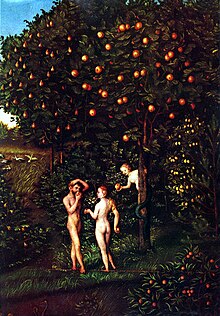
The apple is generic to some desire value , and in particular the examination , the temptation of stealing to resist. The most famous story is probably that of Adam and Eve in the Garden of Eden and their expulsion from it, which is told in the Bible. A fruit from the tree of the knowledge of good and bad, which Adam and Eve forbidden to eat in order to become like God , is the trigger. Although the Bible only speaks of “ fruit ” in general terms, the thought has taken hold in the western world that it was an apple. Other fruit, partly due to regional be related to the myth in combination, are fig or pomegranate , but not the - introduced only in modern times to Europe - tomato, the "paradise apple" or tomatoes .
The apple serves as an emblem for the whole subject of paradise , innocence and their loss for humans. This context is processed in many fairy tales, including in the Arab world . In Christian iconography , he represents the entire complex of issues of sin and redemption .
- Hanging on the tree, in connection with the snake, it is the symbol of temptation .
- In the hands of man it is the symbol of sin and the subsequent fall .
- In the hands of Christ he stands for redemption from original sin caused by the fall .
- In pictures depicting the Last Judgment , redeemed hold apples as a symbol of the reconquered Paradise .
- Typical of the late Middle Ages are depictions in which Our Lady gives the child the apple. This means: Christ takes on the sins of the world and thereby redeems humanity. In particular in the veneration of Mary , the context also includes the fact that through Mary he is given the power to absolve people from sin. It is related to the symbol of the imperial orb explained below . The idea of Mary as "the new Eve" is further elaborated, for example in the depiction of Eve distributing the apples to sinners and Mary distributing the hosts to the believers (Missal by Berthold Furtmeyr , 1481, Munich) or the snake with the apple in the mouth at Mary's feet as an indication of overcoming original sin.
The apple confronts people with the choice between a loved one and personal gain . In some versions of the sagas, Wieland the blacksmith is supported by one of his brothers. This one is a famous archer and hunter. To test him, King Niden has him shoot an apple off his son's head. This apple shot is also known from Wilhelm Tell . The golden apple is a price to be paid to win a spouse . Examples are Hippomenes' advertisement for Atalante, or in the Grimm fairy tales Einäuglein, Zweiäuglein and Dreiäuglein , Der goldene Vogel or Eisenhans .
The apple as a harvest
The apple - especially the one falling from the tree - symbolizes the context of harvest and the wealth and power that arise from it , also in the spiritual sense of knowledge .
- Frau Holle : The protagonists of this fairy tale encounter, among other things, an apple tree that was full of apples. These shouted to them: "Oh shake me, oh shake me, we apples are all ripe." While the positive heroine fulfilled the tree's wish and wasrewardedfor her hard work , the negative heroinepassed him carelessly and was punished for it.
- The story is told that Isaac Newton, while looking at an apple on an apple tree, and possibly also the fall of the apple from the tree in the garden of Woolsthorpe Manor, came up with the idea that celestial mechanics are based on the same gravity as the fall of apples on the Earth.
- As the imperial orb , the apple in the Central European Empire is the symbol of ownership and the scepter is the symbol of control . This apple was - occasionally - filled with sand or ashes as a memento mori , a symbol of the transience of all earthly power. It is set in a Christian cross , as a sign of the derivation of the claim to power from a higher power , but also of subordination to it.
The bone of contention
Golden Apple
In Greek mythology, the golden apple is represented in the judgment of Paris and as a fruit that grows in the garden of the Hesperides and gives eternal youth.
In the Ottoman tradition, the term "golden apple" (Turkish kızıl elma ) was used as a synonym for each of the not yet conquered four Christian capitals, which were crowned by golden globes. As major centers of power of their time, they were the primary targets of potential conquests by the expanding Ottoman Empire.
- Constantinople (until it was conquered by the Ottomans and renamed Istanbul )
- Buda
- Vienna (up to the second failed siege ) and
- Rome .
In Norse mythology , the goddess Idun is, among other things, the guardian of golden apples.
Apple seed chain
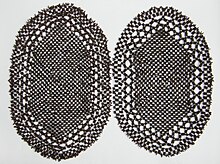
As a leisure activity, the still fresh and therefore still soft apple pits are pulled onto a thread with a needle. The end result is knotted into a bracelet or, if the collection is abundant, a necklace .
Apfelbutz (en)
From an apple that has been mostly incompletely eaten by biting off all over, the Butz (Butzn, Butzen; Apple Griebs, Kitsch (e), Nüssel) remains .
See also
literature
- Eckart Brandt: Brandt's lust for apples. Mosaik, Munich 2000, ISBN 3-576-11441-6 .
- Eckart Brandt: My big apple book. Bassermann, Munich 2003, ISBN 3-8094-1533-2 .
- Pierre-Marie Valat, Pascale de Bourgoing: The apple and other fruits. Meyers Lexikonverlag, Mannheim 1992, ISBN 3-411-08541-X .
- Ernst Ludwig Loewel, Siegfried Labus, Wiebke Fuchs (arr.): German apples: the commercial varieties. Northern Germany and the Lower Elbe. An image . Friends of the open-air museum at Kiekeberg, Rosengarten-Ehestorf 2005, ISBN 3-935096-15-1 .
- Walter Karberg, Cathy Schernus: The apple book Berlin-Brandenburg. be.bra verlag, Berlin 2013, ISBN 978-3-86124-676-3 .
- Robert Nicholas Spengler: Origins of the Apple: The Role of Megafaunal Mutualism in the Domestication of Malus and Rosaceous Trees. Frontiers in Plant Science, 2019. doi: 10.3389 / fpls.2019.00617 .
Web links
- Deciphering the genome of the apple
- Fruit variety leaves from old apple varieties
- Map of Germany "Beginning of the Apple Blossom" over different years
- Apple (extensive multimedia documentation on the topic with special consideration of the situation in Austria - Land creates life eV )
- Thomas Meyer: Data sheet with identification key and photos at Flora-de: Flora von Deutschland (old name of the website: Flowers in Swabia )
- Hans-Peter Schifferle , Christoph Landolt : Berner Rose, Eppeeri-Öpfel, Suurgkunden & Co., in: Wortgeschichte from August 31, 2015, ed. from the Swiss Idioticon (linguistic information on the names of apple varieties).
Individual evidence
- ^ Otto Wilhelm Thomé: Flora of Germany, Austria and Switzerland . Gera 1885.
- ^ Westermann School Atlas. Georg Westermann Verlag, Braunschweig, 2nd edition 1971, p. 41.
- ↑ The WDR's "Apple Blossom Land 2007" campaign provides more detailed information on the apple blossom time ( Memento of February 11, 2013 in the Internet Archive )
- ↑ What the spring bloom reveals about climate change. NDR, January 16, 2019, accessed on February 2, 2019 .
- ↑ http://steiermark.orf.at/news/stories/2585857/ Fruchtfall: Apple farmers fear for harvest, ORF.at, May 25, 2013.
- ↑ Jeanelle Boyer, Rui Hai Liu: Apple phytochemicals and their health benefits. In: Nutrition Journal . 3, 2004, doi : 10.1186 / 1475-2891-3-5 .
- ↑ Rong Tsao, Raymond Yang, J. Christopher Young, Honghui Zhu: Polyphenolic Profiles in Eight Apple Cultivars Using High-Performance Liquid Chromatography (HPLC). In: Journal of Agricultural and Food Chemistry . 51, 2003, p. 6347, doi : 10.1021 / jf0346298 .
- ^ Erich Oberdorfer : Plant-sociological excursion flora for Germany and neighboring areas . With the collaboration of Angelika Schwabe and Theo Müller. 8th, heavily revised and expanded edition. Eugen Ulmer, Stuttgart (Hohenheim) 2001, ISBN 3-8001-3131-5 , pp. 502 .
- ↑ a b c d Ruprecht Düll , Herfried Kutzelnigg : Pocket dictionary of plants in Germany and neighboring countries. The most common Central European species in portrait. 7th, corrected and enlarged edition. Quelle & Meyer, Wiebelsheim 2011, ISBN 978-3-494-01424-1 .
-
↑ Crab apple + Malus sieversii + Malus baccata according to molecular biological research around Amandin Cornille, 2012. Quoted in Arche Noah magazine, April 2015
on C. Peix: Old genes for new apples on YouTube - ↑ Brigitte Bartha-Pichler, Frits Brunner, Klaus Gersbach & Markus Zuber: Rose apple and Goldparmäne: 365 apple varieties - botany, history and use . AT-Verlag, Baden and Munich, 2006, ISBN 3-03800-209-7
- ↑ EU nutritional labeling directive (90/496 / EEC) and Rewe nutritional table.
- ↑ H.-D. Belitz, Werner Grosch, Peter Schieberle: Textbook of food chemistry . Springer-Verlag, 2007, ISBN 978-3-540-73202-0 , p. 865 ( limited preview in Google Book search).
- ↑ Helmut Horn, Cord Lüllmann: The great honey book. 3. Edition. Kosmos, Stuttgart 2006, ISBN 3-440-10838-4 , p. 30.
- ↑ 115. Use of the fruit harvest. (PDF) In: Statistics, Chapter C, Agriculture. Federal Ministry of Food and Agriculture, accessed on December 11, 2015 .
- ↑ Ernst Höhn: Fruit pulp firmness in table apples: market demands, harvest time and storage . In: Swiss magazine for fruit and viticulture . tape 15 , no. 1 , January 2001, p. 410-413 ( [1] ).
- ↑ Production of selected products of the producing food industry. In: Statistics, Chapter C, Agriculture. Federal Ministry of Food and Agriculture, May 2, 2012, accessed on December 11, 2015 .
- Jump up ↑ Rolf Stehr, Walter Guerra, Lorenzo Berra, Ignasi Iglesias, Sandrine Codarin, Thomas Rühmer, Simon Egger: Development of the apple and pear range in Europe . In: Swiss magazine for fruit and viticulture . tape 147 , no. 21 , August 2011, p. 8–11 ( [2] [PDF]).
- ↑ a b entry Malus domestica Borkh. in Liber herbarum II (September 30, 2006).
- ↑ M. Fix: "An Apple A Day" - why apples never get cancer. (PDF; 3.6 MB) In: Insight. 1, 2009, pp. 22-23.
- ↑ Dieter Kremp: Take a bite, Adam! Secrets about the apple. From the myth of the apple tree . Engelsdorfer Verlag, Munich 2013, ISBN 978-3-86268-389-5 , pp. 125 ( limited preview in Google Book Search).
- ↑ Another test on pesticides in apples. In: suedtirolnews.it. Retrieved January 14, 2019 .
- ↑ www.fruchtportal.de Retrieved on February 9, 2014.
- ↑ a b Crops> Apples. In: Official FAO production statistics for 2018. fao.org, accessed on February 26, 2020 .
- ↑ FAO trade statistics 2016 , accessed on August 31, 2019
- ↑ Glenn, D. E Prado, A. Erez, J. McFerson, G. Puterka. A reflective, processed-kaolin particle film affects fruit temperature, radiation reflection, and solar injury in apple. In: J. Amer. Soc. Hoard. Sci. Volume 127, Number 2, 2002, pp. 188-193.
- ↑ Federal Statistical Office
- ↑ Apple Calories, Carbohydrates & Sugar | How healthy are apples really? In: Quick Knowledge - Guides, Instructions and Tips. Retrieved on March 12, 2019 (German).
- ↑ European apple prices better on average. Retrieved March 12, 2019 .
- ↑ a b Holiday ideas around the apple. Educational trail, museums and festivals. In: Bodensee Ferienzeitung. Edition 2/2009. Südkurier Medienhaus, Konstanz 2009, p. 6.
- ↑ Federal Ministry of Agriculture, Forestry, Environment and Water Management, Department II 1, Green Report 2016, Tab_2016_20127_Obstanlagen_Sorten
- ↑ Telephone call from Steirerfrucht Betriebsges.mbH & Co KG, St. Ruprecht an der Raab, on May 19, 2014.
- ↑ Web site OPST , accessed on May 19, 2014.
- ^ Ministry for the Environment, Agriculture, Food, Viticulture and Forests, Rhineland-Palatinate : MCP - Effects in Apple Storage ( Memento from October 21, 2013 in the Internet Archive ), seen in 2012.
- ↑ Höhn E., Baumgartner D., Crespo P., Gasser F .: Ripening control and apple storage with 1-methylcyclopropene (MCP). In: agrarforschungschweiz.ch . 2007, accessed August 24, 2019 .
- ↑ Yves Demuth: “Marktfrische” Swiss apples: “Fresh” from last year. In: observer.ch . August 19, 2019, accessed January 9, 2020 .
- ↑ Craft idea apple core chain
- ↑ Press release in: Max Planck Institute for the History of Man , May 27, 2019.











